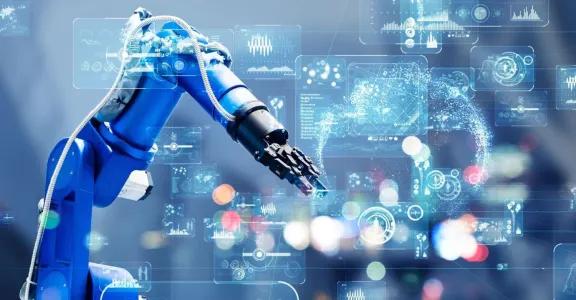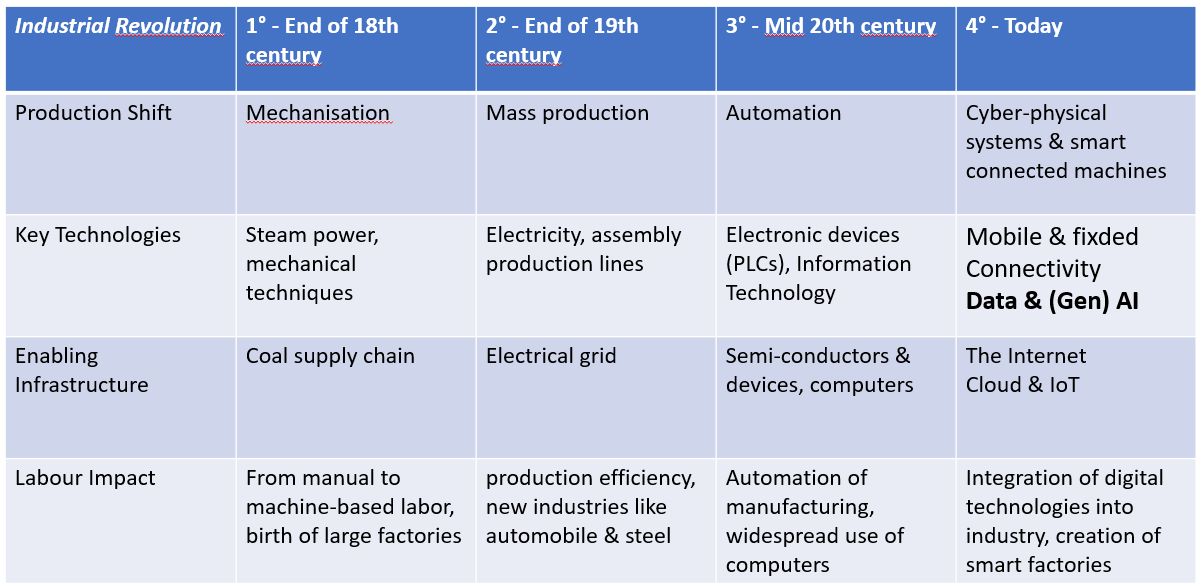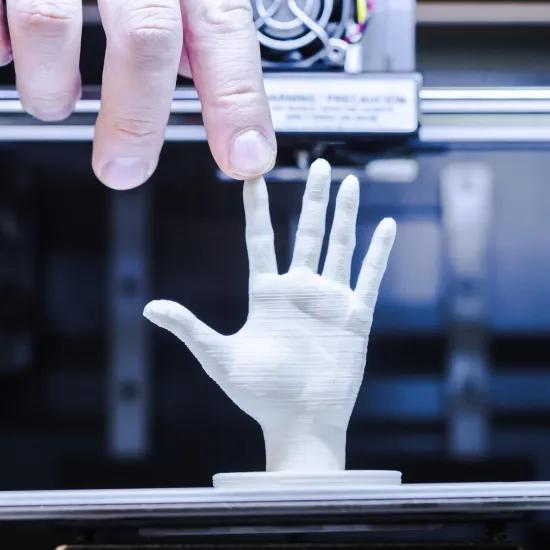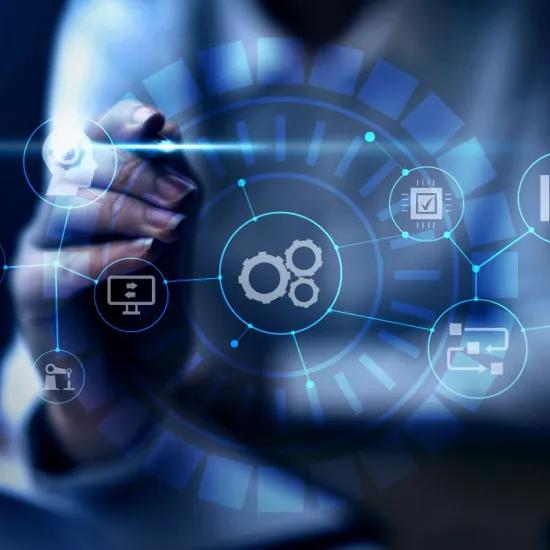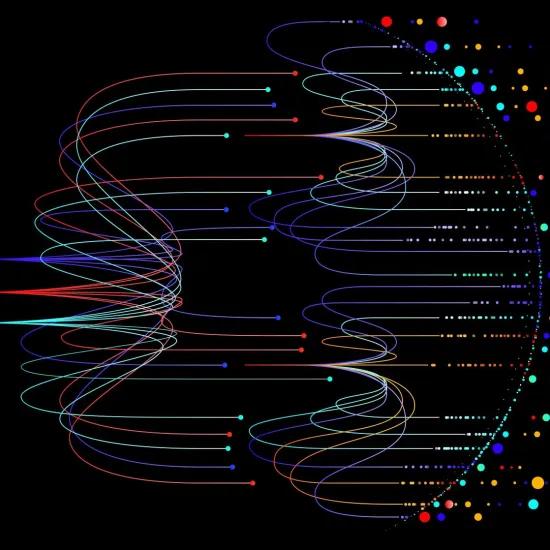Possibilities with GenAI in the spotlights
The fourth industrial revolution – Industry 4.0 - is accelerating rapidly worldwide as interconnected smart machines, AI and data applications, and cyber-physical production systems have reached a high level of technological maturity. The technologies shaping the factory of the future are now available for mass deployment. Generative AI enhances this transformation further with new opportunities for product development and further automation of the production workflow.
The annual turnover growth in the American manufacturing industry has stagnated at around 1.4% over the past twenty years. In the last five years, however, American manufacturing companies have increased their productivity significantly. According to Mckinsey, the total shareholder return of the manufacturing industry is about 400 basis points higher than in the previous 15 years (2). This boost in the manufacturing industry is driven by policy measures that encourage the reshoring of industries such as semiconductor production and technologies for renewable energy in the US.
Another key reason behind the increased productivity is the technological maturity of digital solutions and digitally-driven (cyber-physical) production systems. Smart interconnected machines equipped with all sorts of sensors, proactive maintenance solutions, and various AI and data applications are taking efficiency and automation to new heights. The fourth industrial revolution is at a turning point. (see Figure 1).
1.Up to 70% reduction in the physical product design cycle time
Gen-AI enables industrial designers to explore more product ideas and concepts and to accelerate design cycles significantly. It provides the ability to visualise numerous concepts realistically, and thus to obtain more precise feedback from potential customers much faster.
GenAI applications and copilots are bringing high added value in product development as well as in production processes.
GenAI tools derive insights from infinitely more diverse data sources than humans can analyse on their own. Industrial designers can consequently build a much richer knowledge base and generate many more design variations. Text-to-image GenAI tools offer enormous potential for inspiration and innovation. The technology can generate numerous highly realistic images based on instructions from experts (via text prompting), making iteration much easier. Product design cycles can thus be shortened by up to 70% (1). Human expertise remains essential, nonetheless. Design experts are crucial to ensure that the technology will yield meaningful results. Their knowledge and experience remain crucial for assessing the numerous GenAI designs for manufacturability and aesthetics. Streamlined collaboration between humans and tools will ultimately determine the delivery of a design that resonates with users, can be effectively produced, and results in a more eco-friendly end result.
Ecodesign of materials and products gets a boost with GenAI
The core of ecodesign is to minimise the impact on energy, materials, and waste throughout the entire lifespan of a product (3). The degree of sustainability of products is determined during the design phase: decisions made in the design phase determine 80% of the environmental impact of a product. Ecodesign can thus bridge the gap between value creation and product sustainability. This sometimes requires major system changes, and this is precisely where GenAI tools can provide significant support:
- Airbus and Autodesk are using generative eco-design in a pilot project to reduce the weight of aircraft partitions by 45% while maintaining the structural integrity of materials in the highly demanding aviation industry. The result? "An incredibly strong yet lightweight cabin partition - and the first step towards creating the eco-aircraft of the future (4)."
- General Electric uses GenAI tools to design the blades, rotors, and aerodynamic components of gas turbines (5). The design method starts from the performance requirements of the aerodynamic components, and is thus output-driven. Material properties are simulated to test the behaviour of components under different conditions, and in so doing to identify weaknesses, optimise product performance, and aim for as little material waste as possible in the design phase itself. Furthermore, the overall design cycle time has been reduced from a year to just a few months.
- Microsoft and an American research institution have used AI to discover, in just a few weeks, a new solid-state electrolyte that could eventually form the basis for a new type of battery that is less prone to fire and requires significantly less lithium (6). Such materials research is typically very complex with very long lead times. Moreover, the success rates of the research are relatively low because the number of possible combinations of raw materials and material compositions is enormous. (Gen)AI algorithms can now analyse and reduce millions of possible combinations of raw materials and material properties to just a few viable combinations. In this example, 32 million possible material combinations were reduced to 18 viable candidates in just a few weeks instead of years. The 18 candidate material combinations are then designed and tested in the real environment.
Digitale Twins: GenAI synthetic images as test data for classical AI algorithms
Ford is using a mix of AI and GenAI to refine and test more extensively the intelligent algorithms of self-driving vehicles in virtual environments (7). The AI algorithms of the vehicles are trained using synthetic images generated by GenAI tools. This technique has now found its way into many applications. GenAI tools generate synthetic data that simulate real production scenarios and serve as additional input for training various analytical (or classical) AI models and algorithms.
Likewise, the Belgian company Vintecc combines the power of AI computer vision and GenAI synthetic data (8). For instance, Vintecc develops AI algorithms for sorting complex natural products such as fish and potatoes for the Vlaams Instituut voor Landbouw-, Visserij- en Voedingsonderzoek (ILVO) [Flemish Institute for Agriculture, Fisheries and Food Research] and the agricultural machinery company AVR. Classical AI algorithms can be trained much faster and more accurately with a combination of real and synthetic data.
2. GenAI in production: Support for machine operators and plant engineers
Predictive (‘classical’) AI applications have led to better (real-time) understanding of production processes, greater production stability, and higher predictability of the end-to-end workflow, including inventory management and order management. Known applications include predictive maintenance of machines (whether or not) in production lines and visual quality control of products. Data from various sensors on connected machines are analysed using AI to identify patterns, predict failures, and then schedule machine maintenance. Automated visual inspection systems use AI to detect defects in products, for example, with 360° cameras on a conveyor belt. The AI algorithm is pre-trained using captured images of products (possibly in combination with GenAI synthetic data) with predefined quality standards. A similar application is intelligent Pick & Place robots in assembly applications. These robots grab incoming parts from one location, such as a conveyor belt, and place or attach the part to another piece of the item. With AI, it is no longer necessary to place each type of part in separate compartments, but all types of parts can enter on the same conveyor belt, for example, because the robot recognises them. There are numerous Belgian companies with such AI solutions such as I-Care, yazzoom, Heliovision, Vintecc, Azumuta, Kapernikov, Robovision, and many others. An overview of AI companies and many use cases are posted on the Agoria AI web page.
Generative AI is not a replacement for ‘classical’ or predictive AI but is a complementary technology (see box entitled “Technology in a nutshell”). The content creation capabilities of GenAI bring new applications to support machine operators and to generate recommendations based on production status and will also lead to greater autonomy of machines and robots.
GenAI functionality can be developed at both the machine level and the system or workflow level. GenAI increases the efficiency of hands-on tasks such as programming machines. Instead of programming PLCs (Programmable Logic Controllers) manually, a GenAI tool can generate code via text prompting, similar to GenAI support in software development. GenAI can generate action plans system engineers based on historical data with step-by-step instructions (text, images, and even videos). Such GenAI action plans for machine defects may include a list of defect analyses, relevant replacement parts, and even a list of possible suppliers.
GenAI tools are particularly useful for generating all sorts of technical documentation and manuals. Manuals require extremely high quality, often in different languages. ISO standards and CE conformity often require very extensive files to be prepared, for which GenAI is an excellent tool. Yamagata (10) is an example of a company that specialise in such technical documentation.
From predictive to prescriptive maintenance
Several companies such as Siemens, ABB, Schneider Electric, and SymphonyAI are introducing GenAI Industrial Copilots to support machine operators, system engineers, and technicians. Operational issues can be identified and analysed much faster with GenAI Industrial Copilots. The copilots also generate a proposed action plan with corrective measures so that action can be taken much faster.
The international company SymphonyAI, which has a significant presence in Leuven, launched a SymphonyAI Copilot at the end of last year with three role-based Copilots: a Plant Performance Copilot, a Digital Manufacturing Copilot, and the Connected Worker Copilot (11). These three industrial copilots are explicitly designed to meet the specific needs of various roles in production and provide personal assistance for improved efficiency and productivity.
Siemens introduces GenAI functionality at both the machine level and the workflow level. Siemens and Schaeffler have integrated a GenAI Industrial Copilot in production machines (12). The Industrial GenAI copilot supports machine operators and engineers in generating code for PLCs (Programmable Logic Controllers).
Furthermore, the GenAI copilot is connected to the engineering framework, which gives it access to all relevant documentation, guidelines, and manuals to help employees on the shop floor identify identifying potential errors. Such capabilities enable maintenance teams to detect errors more quickly.
The Siemens Senseye Predictive Maintenance application has been enhanced with GenAI functionality at the system and workflow level (13). The app can scan and group GenAI cases, even in multiple languages, and search for similar cases (and their solutions) from the past to provide context for current issues. Data need not be of high quality for the generative AI to convert them into actionable insights. By contextualising the available information better, the app can derive a prescriptive maintenance strategy. It generates automatically behavioural models for machines and maintenance protocols for employees.
ABB has entered into a partnership with Microsoft to add GenAI functionality to the ABB digital platform Ability™ Genix to handle, analyse and manage complex Industrial Internet of Things (IIoT) environments (14).
Schneider Electric has likewise entered into a partnership with Microsoft to add a GenAI Copilot to its EcoStruxure Resource Advisor platform, which is used to help industrial companies observe and drive their energy management, CO2 emissions, resource consumption and ESG reporting (15).
3. A glimpse into the Future: ChatGPT with Hands and Feet
Six months after the launch of ChatGPT, the feeling was that the technology would add value primarily to the ICT sector and the service industry. Sure enough! It is abundantly clear today, however, that the technology also has tremendous potential in the manufacturing industry. GenAI brings significant efficiency and innovation to product development, production workflow processes, and – as in all sectors – also in supporting functions such as marketing & sales and legal & contracting. Every manufacturing company can already leverage GenAI tools in virtually all areas of operations.
And this is only the beginning. Researchers and high-tech companies are currently working on GenAI solutions that enable machines and robots to interact with humans in a natural way and to adapt to new environments and learn from their own mistakes. Work is underway on generative AI Robotica Foundation Models (RFMs) to make the deployment of smart, multimodal robots and cobots a reality. Two examples are the robotics companies Covariant (16) and Figure (17). Covariant's RFM-1 is trained on large amounts of text – like ChatGPT – and on video and hardware control and motion data from tens of millions of examples of robot movements from manufacturing companies. "The model has already demonstrated that it can learn to control such hardware that are not present in the training data. With further training, a humanoid robot can be controlled with the model," says Belgian Pieter Abbeel, professor at Berkeley and co-founder and chief scientist of Covariant (16).
Figure announced a partnership with OpenAI on 29 February 2024, along with the completion of an investment round with Microsoft, Nvidia and Amazon. In an interview, CEO Brett Adcock casts a glance onto the future: "We see a huge advantage in having a large multimodal RFM on the robot, so we can communicate with it and provide what we call 'semantic understanding," he says. "That ability to understand language and act on it should enable robots to interact smoothly with employees in, for example, a warehouse or on the production floor.” (18) So, robots and cobots are getting a second wind, and what a blast it is!
The physical and digital worlds are becoming completely intertwined. Everyone remembers the launch of Sora in mid-February (19), the highly realistic text-to-video model of OpenAI. The results are breathtaking, but the synthetic videos occasionally exhibit some violations of the basic laws of physics, such as gravity, here and there. "An intriguing aspect of Covariant's work is that it can help the underlying AI models understand the physics of the world better," says Pieter Abbeel, Covariant's chief scientist (16). And he concludes: "OpenAI's Sora is (today) struggling to depict accurate human anatomy and basic physics... but our research and (our model) Robotica Foundation Model-1 will eventually address this issue."
What conclusion can we draw here? In any event, it all comes down to riding this unprecedented technological wave today: To research, experiment, and try out GenAI technology so that we don't miss the boat tomorrow and see the competition outpace us.
Analytical and Generative AI in manufacturing
Analytical – or 'classical' – AI is suitable for analysing, classifying, clustering, and ranking data. Analytical AI performs discrete actions on context-specific data. Machine Learning (ML) algorithms discern patterns in observed data so that they can generalise these patterns for new data. For instance, an ML model can be trained with specific text fragments, such as operator incident reports in which machine failures are classified according to causes such as "end of tool life" or "operator error." Based on this training, the model can classify new reports according to cause. Important AI applications in manufacturing include the proactive and predictive maintenance of machines, detecting anomalies in the production process, (visual) inspection and quality control of products, bin picking solutions combined with robots, and predictive inventory management with associated planning and workflow optimization for suppliers.
Generative AI is not a replacement for analytical AI but offers complementary use cases. GenAI not only classifies texts but can also create new text based on specific criteria and user input through (iterative) text prompts. GenAI is based on foundation models such as ChatGPT. These models are for instance trained on all available online text first and are then refined for context-specific applications. In the example of machine failures and operator instructions, the model first learns what understandable language is and then is refined by learning what operator instructions look like and how they correlate with causes of machine failures. This way, GenAI can create instructions for the machine operator describing a process to solve a particular cause of a machine failure.
This article also appeared on Agoria's website.
Written by Danny Goderis (Agoria).
AI:Unboxed - Make AI Work!Do you want to learn about AI or understand what this technological revolution could mean for your business, your job and all businesses in the digital and manufacturing sectors? Attend AI:Unboxed, the annual Sirris and Agoria members' event at Brussels Expo on 29 May. The programme includes a keynote speech by Professor Ethan Mollick, a roundtable discussion on the European AI ecosystem, breakout sessions with over 20 technology companies and a technology fair with the most spectacular real-world applications of AI. |
